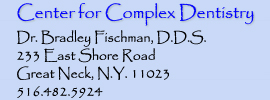 |
 |
In their article: “Experimentally induced abutment strains in three types of single-molar implant restorations” (J Prosthet Dent 2000; 84; 318—326) Drs. Seong, Korioth, and Hodges, placed strain gauges on the mesial, distal, buccal and lingual locations on a crown supported by a single 3.75mm implant, a 5mm implant, or two 3.75mm implants. They then loaded the teeth from varying directions.
The results showed the greatest strain was always on the single 3.75mm implant. By increasing the diameter of the implant from 3.75mm to 5mm the stress was then decreased by 40%. Two 3.75mm implants decreased stress further, but not that significantly. Changing the location of centric contacts, however, may have had a bigger impact on strain than increasing the number or diameter of the implants. In fact, the results indicate that offset centric contacts may be effective counteracting specific implant bending moments. All this supports the use of the maximum size and number of implants, as well as placing occlusal contacts in relation to implant positions to decrease stress from occlusion.
 |
||
| fig. A Single 3.75mm implant | fig. B Single 5mm implant |
fig. C Two 3.75mm implant |
A similar topic has been addressed by Dr. O’Mahony, Bowles, Woolsey, Robinson, and Spencer, in their article: Stress Distribution in the Single-Unit Osseointegrated Dental Implant: Finite Element Analyses of Axial and Off-Axial Loading (Implant Dent 2000;9:207-218).
The computer represented the implant with cortical and cancellous bone measuring the stress created at all points along the implants and imagined mandible. The point of load was moved varying distances from the axial center of the implant and the stresses determined.
Even though computer model of bone makes many assumptions, there are several interesting findings in this study:
- Under axial loading, the greatest stresses at the implant/bone interface were at the apex of the implant and compressive in nature.
- Off-axis loading resulted in crestal compressive forces on the side of the load, and tensile forces on the crestal side opposite the load.
- Compared with axial loading, compressive stresses were 3x greater at 2mm from the axial, 5x greater at 4mm, and 7x at 6mm.
- Tensile stresses were increased from the 2m off axial load by 3x at 4mm, and 5x at 6mm.
The evidence points to crestal bone loss being related to the circumferential nature of the crestal connective tissue. This presents the easiest path for bacterial invasion and therefore crestal bone loss. There is probably a relationship between this bacterial action and the amount of stress the bone is under. The large increases in crestal stress, both compressive and tensile, that occur with off loading may be contributing factors in crestal bone loss, and the high rate of maxillary implant loss (where all forces are off loaded).
Dentures | Extreme Makeovers | Doctor's Credentials | Map & Policies | Contact Us
Home | Professional Referrals | Tidbits for Dentists | Newsletters for MDs